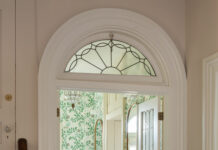In a suburban development in Phoenix, Maryland, it’s easy to spot Jack and Jean Lowry’s home. Their acclaimed collection of trees and plants begins curbside. An artistic, year-round tapestry of conifers, Ginkgoes and Japanese maples—highly textured and in a spectrum of yellows, greens and reds—offers the Lowrys screening from the road and their neighbors a glimpse of a first-class garden more than five decades in the growing.
A border of witch hazel along the driveway gives fragrant and early spring welcome as well as golden fall color. By the front lawn, an American arborvitae topiary Jack clipped to resemble a golfer greets visitors and gives a nod to the nearby Hillendale Country Club as well as to Jack’s sense of humor.
“Bare” is the word he uses for the pie-shaped, two-thirds acre he and Jean found around the brick home where they, and their three children, moved in 1964. With them, they brought a dawn redwood tree, which measured 3 inches in diameter. Now it is 3 feet wide, 58 years old and 60 feet tall. That tree kicked off a rapidly expanding collection of fine and unusual trees and plants that today fill a series of well-designed gardens. Around the front lawn, rear pond and patio, curved paths flanked by gardens ring the property and make it seem larger. The diversity of plant material, which repeats front to back and flows harmoniously throughout the gardens, furthers the perception of space.
 “Jack plants plants that people said wouldn’t grow in this area,” says Jean, who had never been interested in gardening until she met Jack. He grew up in a Pittsburgh family of green thumbs and graduated with a degree in horticulture from Penn State, before managing a garden center and working in the landscape business.
“Jack plants plants that people said wouldn’t grow in this area,” says Jean, who had never been interested in gardening until she met Jack. He grew up in a Pittsburgh family of green thumbs and graduated with a degree in horticulture from Penn State, before managing a garden center and working in the landscape business.
Jack says fir trees, his passion—like the towering Nordman fir that’s a focal point of a front garden—are examples of trees not found in abundance in Maryland gardens. “They don’t like clay soil, but we have good soil here, and I usually can find a proper location for what I want,” says the renowned nursery representative who, in 1964, founded Lowry & Company to represent growers to the nursery trade. Jack began by representing five growers in the Maryland-Virginia area, then went nationwide and represented nurseries up and down the East Coast, plus 15 on the West Coast. The company specialty was taking rare and choice plants to the trade. Jack is venerated in the industry and, among many honors, has received, for lifetime achievement and service, the prestigious honorary membership in the Maryland Nursery and Landscape Association.
Jack’s deep knowledge of and access to plants enriched his home garden, where he sometimes tested plants. Previously farmland, the soil continues to be fertile and ready to receive whatever struck his fancy. “We were able to collect almost any plant in the country due to our occupation,” Jack says. He did all of the design, planning and digging himself. Jean, the bookkeeper for the business, weeded and occasionally deadheaded. Most importantly for Jack, she “never said no” to one of his ideas or plants for the garden.
Today, his top three favorites, among hundreds here, are “our collection of Japanese maples, the Nordman fir [never yet pruned] and the dawn redwood.” He quickly adds other top picks: Gingko trees (including dwarf varieties), which have golden fall color and drop their leaves at once for easy raking; a collection of dwarf Kingsville boxwood from renowned nurseryman Henry Hohman; a statuesque, deciduous paper bush (Edgeworthia chrysantha); variegated dogwoods, including a Wolf Eyes Chinese dogwood; daphne, particularly the three-season blooming ‘transatlantica’ variety; and a Blue Atlas cedar he espaliered on the chimney 50 years ago.
 As well as fall interest, many trees add a sculptural element to the garden. Weeping trees—a Norway spruce, purple beech and Japanese snowbell—give graceful, vertical interest. A yellow-flowering Elizabeth magnolia offers pyramidal geometric counterpoint to the adjacent dawn redwood. A nearby fastigiate beech brings another pyramidal shape.
As well as fall interest, many trees add a sculptural element to the garden. Weeping trees—a Norway spruce, purple beech and Japanese snowbell—give graceful, vertical interest. A yellow-flowering Elizabeth magnolia offers pyramidal geometric counterpoint to the adjacent dawn redwood. A nearby fastigiate beech brings another pyramidal shape.
Bark texture gives another dimension to four seasons of interest with shaggy bark and paperbark maples as well as a mature seven-son tree that normally is multi-stemmed, but here is single stemmed. “I didn’t have the room,” Jack says.
Seated on the patio, he points out a collection of succulents, including giant kalanchoe, an American agave and an orchid cactus. Regular visitors to a stand of feeders and birdhouses include hummingbirds, bluebirds and flickers.
Human visitors come via tours of professional and amateur horticulturalists, most recently with the 2016 Horticultural Society of Maryland. “Four-hundred people came,” says Jean, who three times has served as president of the Lutherville Garden Club, once as district chairman of the Federated Garden Clubs and twice taken the rigorous courses to earn a gold star from National Garden Clubs. With both Lowrys now 85, yet not retired, Jean and Jack have closed their office and moved their business home. When asked about their current outdoor projects, they say in unison: “Maintenance!”





Wonderful to read this article. Met JEAN 2 yrs. AGO after joining the Lutherville Garden Club. JEAN is gracious and always willing to share any knowledge she has to share. She is also one of the fittest women I have ever Met! She always puts a smile on your face.